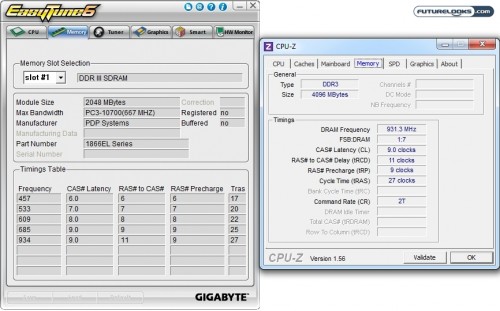
Intel’s Sandy Bridge is a resource hungry platform that can do a lot more than just play your typical 3D crushing video games. All it needs is a high quality motherboard and a decent dual channel DDR3 memory kit to prove it. Coupled with one of best Intel P67 motherboards, we’re going to take a look at the latest killer Patriot Memory Division 2 Viper Extreme 1866MHz DDR3 memory. Let’s go!
Features and Specifications

Division 2 is the newest top of the line dual channel DDR3 memory from the Viper Extreme series designed to support the new Intel Sandy Bridge processor and motherboards featuring the Intel P67 chipset. After a bit of engineering and IC selection, the end result is some well tuned Division 2 modules providing frequencies from 1600MHz to 2133MHz effectively at a mere 1.65 volts using 9-10-9-27 memory timings.
Higher end P67 motherboards offer up to 2133MHz maximum memory speeds which are achieved by overclocking. The best way to achieve stability when overclocking your system’s DDR3 is to utilize the XMP profiles programmed into the memory chips which are available in settings through the BIOS. Our 1866MHz was recognized via XMP profiles automatically, allowing us to configure the motherboard’s BIOS for 1600MHz and 1866MHz with the right memory timings and voltage. It really is that simple!
Finally, there’s a new heat spreader design on the Division 2 modules made from copper. The Patriot Memory Division 2 1866MHz memory kits start at $94 USD at places like Newegg and Amazon.
Test Configuration

The system we are utilizing today has very common components. One important factor is that we’ll be continuing to use high quality power supplies whenever dual video cards or overclocking are involved to increase our chance of success.
- Processor: Intel Core i7-2600K Sandy Bridge LGA1155
- CPU Cooler: Zalman CNPS10X Extreme Ultra Quiet
- Motherboard: GIGABYTE GA-P67A-UD7 (F6 BIOS)
- Memory 1: Patriot Memory Division 2 Viper Extreme 4GB 1866MHz DDR3
- Memory 2: Kingston HyperX Genesis 4GB 2133MHz @ 1866MHz DDR3
- Video Card: MSI NVIDIA Geforce GTX 460 1GB Cyclone
- Storage: Patriot Memory 120GB Inferno SSD
- Power Supply: NZXT Hale90 750-Watt (80Plus Gold)
- Operating System: Windows 7 Professional 64-bit
As mentioned earlier, XMP made setup easy and was detected properly by the P67A-UD7 motherboard. Overclocking this memory is pretty much out of the question given the dividers on this P67A-UD7. The selections are 1066, 1333, 1600, 1866, and 2133MHz with no way of manually increasing those values.
Software Test Notes

One of the benefits of high frequency DDR3 memory is that it can speed up the performance of many software applications. The larger and faster the memory kit, the quicker data can be stored and accessed. That’s why VMWare works so well with tons of memory, but even multiple MS Office type apps, all active at the same time, can benefit. However, it’s been proven time and time again that frame rates in games rarely benefit, but can help the games open and close faster.
Another benefit to high performance memory is that it can be operated at lower frequencies with better timings. What that does is improve memory bandwidth. If your motherboard doesn’t support 1866MHz memory, you can down clock it to 1600MHz or 1333MHz while reducing the timings from 9-10-9-27 to something like 8-8-8 or 7-7-7 respectively.
With these two objectives in mind, we’ll be using Sysmark 2007 to reveal any real world benefits followed by Sisoft SANDRA’s memory bandwidth benchmark which gives us a visual score. The final test will be a H.264 1080 to 720 transcode using Arcsoft Media Converter. On with the show!
